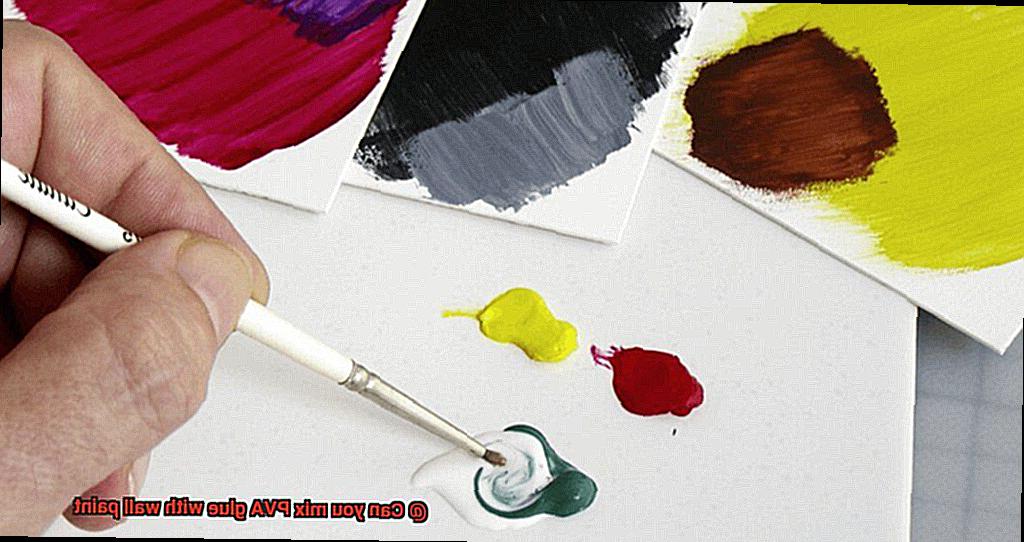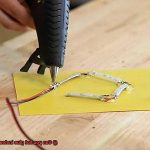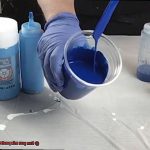Home improvement projects are like a canvas waiting to be painted with endless possibilities. From selecting colors that scream your personality to discovering innovative ways to elevate the visual appeal, painting walls can truly transform any space. But have you ever wondered if there’s more than meets the eye when it comes to paint?
Enter the captivating concept of mixing PVA glue with wall paint. This intriguing combination has been making waves as a cost-effective technique for enhancing paint application and achieving one-of-a-kind effects. However, like any experiment, it comes with its own set of pros and cons that deserve careful consideration.
In this blog post, we’ll dive into the potential advantages and disadvantages of blending PVA glue with wall paint, arming you with valuable insights to make an informed decision for your next painting adventure. So, let’s embark on this journey together and uncover the secret behind this curious fusion.
Advantages of Mixing PVA Glue with Wall Paint
Contents
- 1 Advantages of Mixing PVA Glue with Wall Paint
- 2 Disadvantages of Mixing PVA Glue with Wall Paint
- 3 How to Test Compatibility Before Applying the Mixture
- 4 Preparing the Mixture for Application
- 5 The Ideal Ratio of PVA Glue to Wall Paint
- 6 How to Apply the Mixture Properly
- 7 Drying Time and Texture Considerations When Mixing PVA Glue and Wall Paint
- 8 Other Important Factors to Consider Before Mixing PVA Glue and Wall Paint
- 9 Conclusion
Mixing PVA glue with wall paint offers several advantages:
- Improved adhesion: PVA glue helps the paint adhere better to surfaces, preventing peeling or flaking.
- Crack and peel resistance: The flexibility properties of PVA glue help resist cracking, making it ideal for areas with high humidity or temperature changes.
- Smooth and even coverage: The adhesive properties of PVA glue allow for a smoother and more even coverage, reducing streaks and patchiness.
- Increased durability: Mixing PVA glue with wall paint protects painted walls from everyday wear and tear, saving time and money on frequent touch-ups or repainting.
- Cost-effective solution: PVA glue is relatively inexpensive and easily accessible, making it a cost-effective solution for enhancing paint performance.
However, it is important to note that not all paints and surfaces may be compatible with PVA glue. Testing compatibility and following proper preparation and application techniques are essential for achieving desired results.
Disadvantages of Mixing PVA Glue with Wall Paint
Before you grab that bottle of PVA glue and mix it with your wall paint, take a moment to consider the potential disadvantages that come with this practice. While it may seem like a quick fix or a creative way to enhance your paint job, there are some drawbacks that you should be aware of.
Firstly, mixing PVA glue with wall paint can affect the durability of the painted surface. While PVA glue may provide temporary adhesion benefits, it is not designed to withstand the long-term wear and tear that walls are subjected to. This means that your painted walls may be more prone to chipping, peeling, or cracking over time.
Not only can it affect durability, but the texture and appearance of the paint can also be compromised. PVA glue has a thick and sticky consistency, which can alter the smoothness and evenness of the paint when mixed together. This can result in streaks, clumps, or an uneven application, leading to an unsightly finish that may require additional touch-ups or repainting.
Moreover, mixing PVA glue with wall paint can affect the overall coverage and color consistency. PVA glue tends to have a milky or translucent appearance when wet, which can interfere with the opacity of the paint. This means that your final color may not turn out as vibrant or even as desired.
In addition to these aesthetic concerns, it’s important to note that many paint manufacturers offer warranties for their products when used according to their specific instructions. By deviating from these guidelines and adding substances like PVA glue, you may void any warranty provided by the manufacturer.
Lastly, using a mixture of PVA glue and wall paint can make it more challenging to clean or remove the paint in the future. The presence of PVA glue creates a stronger bond between the paint and the surface, making it difficult to remove without causing damage or leaving residue behind.
How to Test Compatibility Before Applying the Mixture
Testing the compatibility of PVA glue and wall paint before applying the mixture is crucial to ensure a successful outcome for your project. By following these steps, you can determine if the glue and paint are compatible and avoid any potential issues with adhesion or durability.
Gather the necessary materials
Start by collecting a small sample of the wall paint and PVA glue that you intend to mix. It is important to use the same type of paint and glue that you will be using for your project. This will give you the most accurate test result.
Mix the materials together
In a separate container, mix equal parts of the paint and glue. Use a 1:1 ratio to start with, but you can adjust the proportions depending on the desired consistency and texture. Thoroughly stir the mixture to ensure that the glue and paint are well blended. Pay attention to the consistency, texture, and color of the mixture as you mix it.
Apply the mixture to a test surface
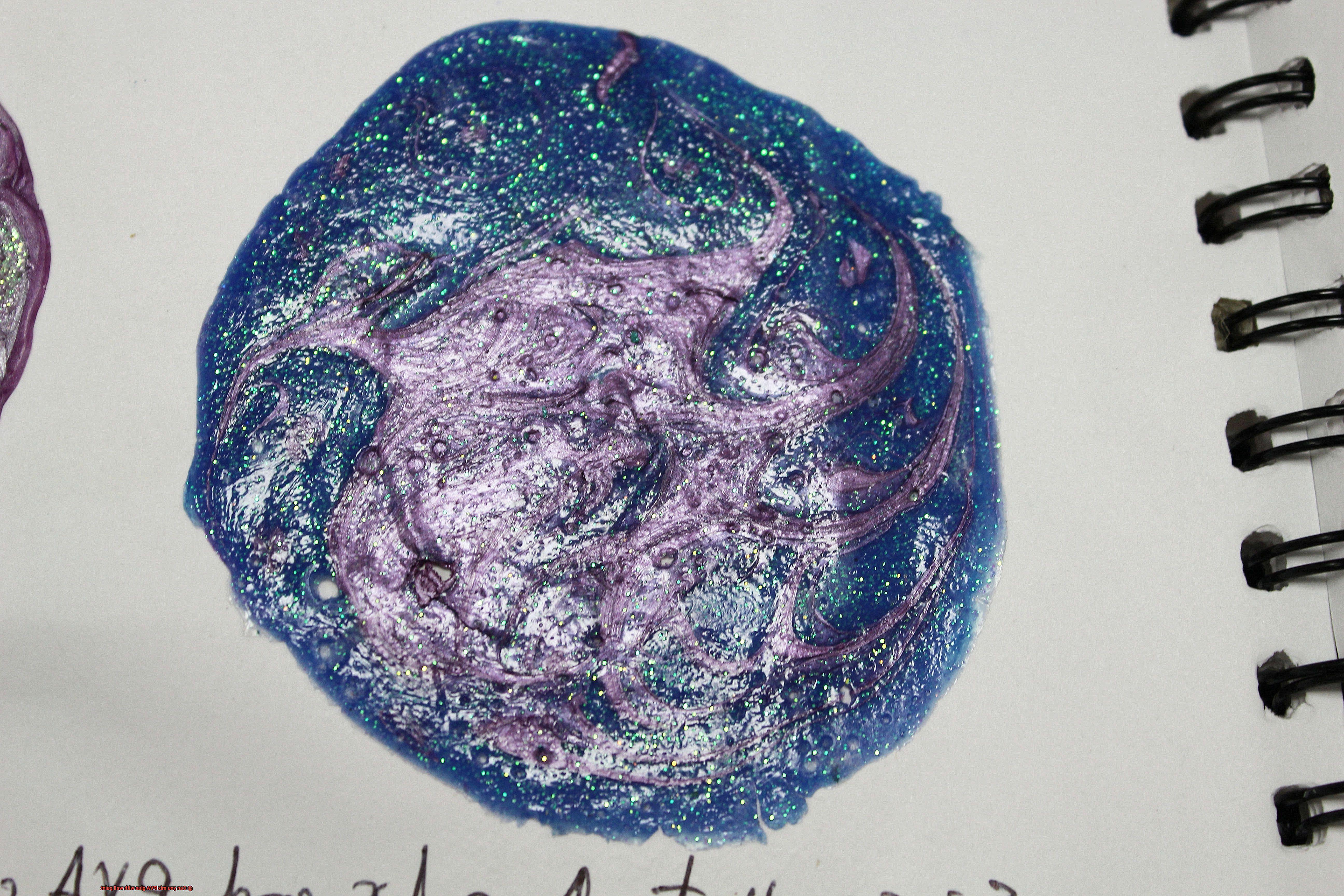
Choose a test surface that is similar to the one you will be working on for your project. It can be a piece of scrap wood, cardboard, or any other material that mimics the intended surface. Use a brush or roller to evenly spread the mixture onto the test surface. Make sure to apply it in an even layer.
Allow the mixture to dry
Give the mixture enough time to dry completely. This may take several hours or even overnight, depending on environmental conditions such as temperature and humidity. It is essential to allow sufficient drying time to observe any potential issues accurately.
Inspect the test surface
Once the mixture has dried, carefully examine the test surface for any signs of cracking, peeling, or other undesirable effects. If the mixture has dried without any issues and appears to be well-bonded to the test surface, it is likely compatible and safe to use for your project. However, if you notice any negative effects such as flaking or poor adhesion, it is best to avoid using the mixture on your intended surface.
Preparing the Mixture for Application
Enhancing the performance and durability of your paint finish can be achieved by mixing PVA glue with wall paint. Whether you want to improve paint adhesion or create a more durable surface, this simple process can help you achieve your desired results. Here’s a step-by-step guide on how to properly mix PVA glue with wall paint for application:
Materials and Tools:
- Container for mixing
- Measuring cup or scale
- Stirring stick or paint mixer
- High-quality PVA glue and wall paint
Step 1: Determine the Proportions
To start, determine the proportions of PVA glue and wall paint you want to mix. While a general guideline is one part PVA glue to ten parts wall paint, adjust the ratio based on personal preference and the project at hand. Gradually adjust the proportions until you achieve the desired consistency and performance.
Step 2: Pour Wall Paint into Mixing Container
Pour the desired amount of high-quality wall paint into your mixing container. Optimal results are achieved with high-quality paints.
Step 3: Add PVA Glue
Slowly add the PVA glue to the mixing container while continuously stirring or mixing the two substances together. Thoroughly blend the mixture until there are no lumps or clumps of glue remaining, ensuring a smooth and even application onto the surface.
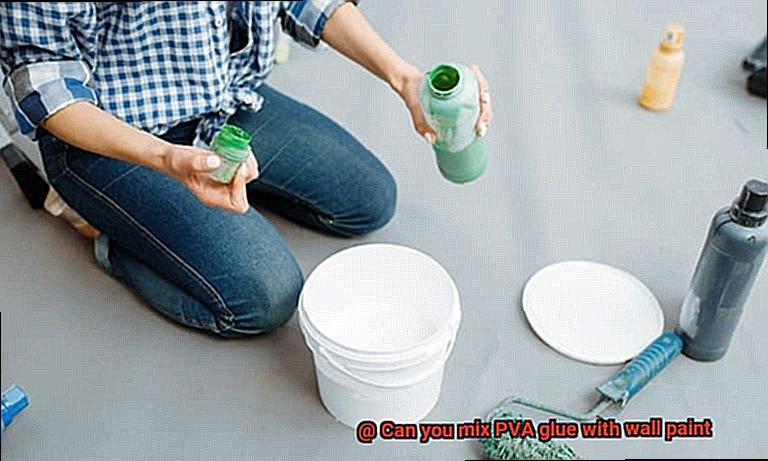
Step 4: Mix Thoroughly
Continue stirring or using a paint mixer until the PVA glue and wall paint are fully blended. This step is crucial in achieving a consistent mixture that will adhere well to your chosen surface.
Tips and Tricks:
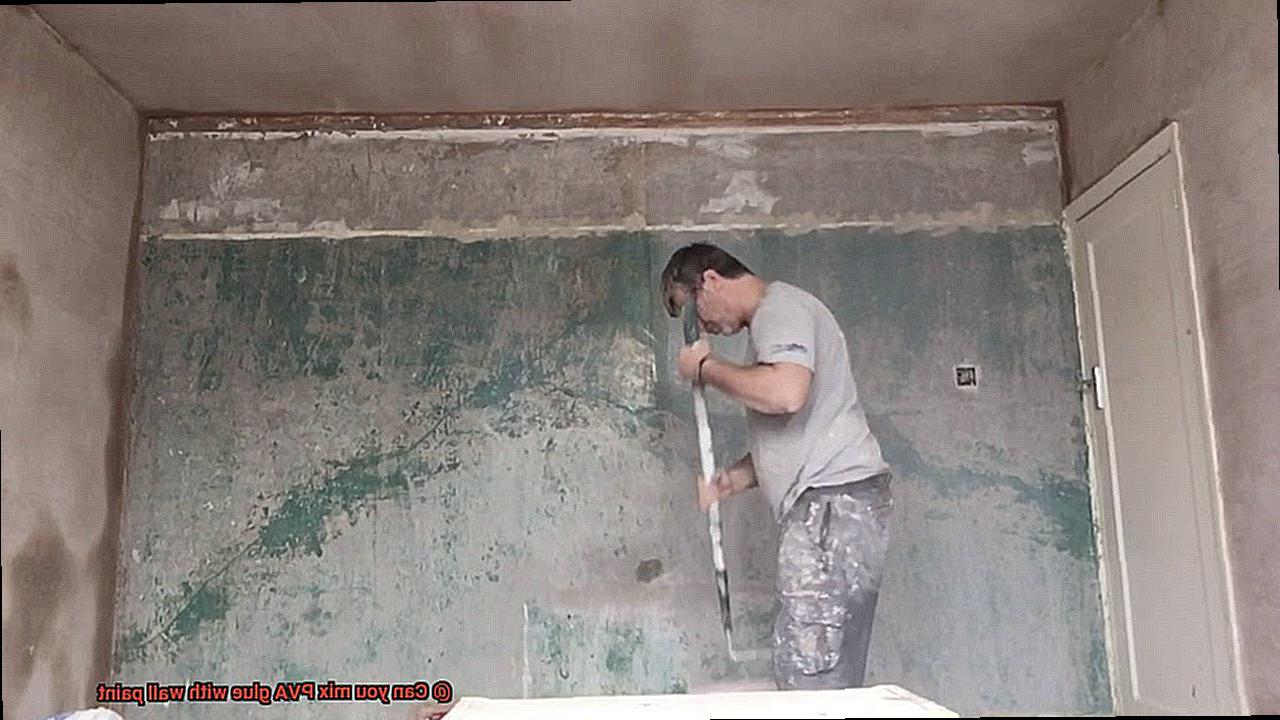
- For larger quantities, consider using a paint mixer attachment on a drill for easier blending.
- Use a disposable plastic container for mixing to simplify cleanup.
- If necessary, wear gloves or work in a well-ventilated area for safety.
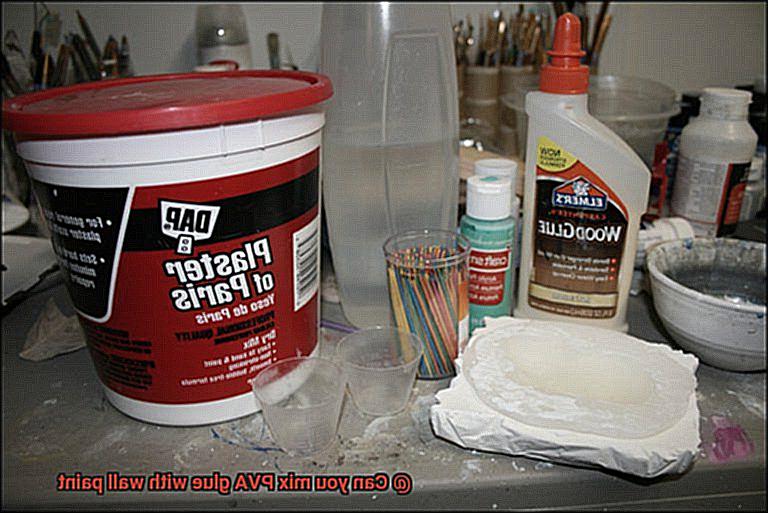
Test and Apply:
Before applying the mixture to your entire project, test it on a small area to assess its performance and appearance. Make any necessary adjustments before committing to the entire surface. Keep in mind that final results may vary depending on factors such as paint type, surface texture, and environmental conditions.
The Ideal Ratio of PVA Glue to Wall Paint
When it comes to gluing and wall paint, finding the ideal ratio of PVA glue to wall paint is crucial for a successful application. Whether you’re working on a small craft project or painting an entire room, understanding the right mixture can greatly enhance the performance and durability of your paint finish.
To start, a good rule of thumb is to mix one part PVA glue with five parts wall paint. This balanced combination promotes better adhesion and ensures the paint will withstand wear and tear over time. However, it’s important to keep in mind that the ideal ratio may vary depending on several factors.
Firstly, consider the type of surface you’re painting. If you’re working with a porous surface or a surface that requires extra adhesion, it’s advisable to increase the amount of PVA glue in the mixture. This will help the paint adhere more effectively and prevent it from peeling or flaking off. On the other hand, if you’re painting a non-porous surface or a surface that doesn’t require strong adhesion, you may be able to reduce the amount of PVA glue in the mixture. This allows for a smoother application and prevents the paint from becoming overly thick or sticky.
Another factor to consider is the type of paint you’re using. Different paints have different consistencies and properties, so it’s important to adjust the ratio accordingly. For example, if you’re using a thicker or more viscous paint, you may need to increase the amount of PVA glue to ensure proper adhesion and flow.

Additionally, it’s always recommended to do a test patch before applying the mixture to the entire surface. This will allow you to assess the adhesion, coverage, and overall performance of the paint and glue mixture. It’s also important to follow any manufacturer’s instructions or recommendations regarding mixing ratios for specific paints or glues. These instructions can usually be found on the product labels or packaging.
How to Apply the Mixture Properly
Before starting, gather all the necessary materials for your project. Make sure you have the correct ratio of PVA glue to wall paint for your specific project. The ratio will depend on the desired consistency and finish, so refer to the instructions on your glue and paint products for guidance.
Once you have the correct ratio, mix the glue and paint together in a separate container. Use a stir stick or paint mixer to ensure a consistent blend. Stir well, making sure to remove any lumps or clumps in the mixture. This step is crucial for achieving an even application.
Prepare the surface
Preparing the surface is essential for proper adhesion and a smooth finish. Begin by cleaning the surface you will be applying the mixture to. Use a mild detergent and water solution to thoroughly clean the surface, ensuring it is free from dust, dirt, and debris. Allow the surface to dry completely before moving on to the next step.
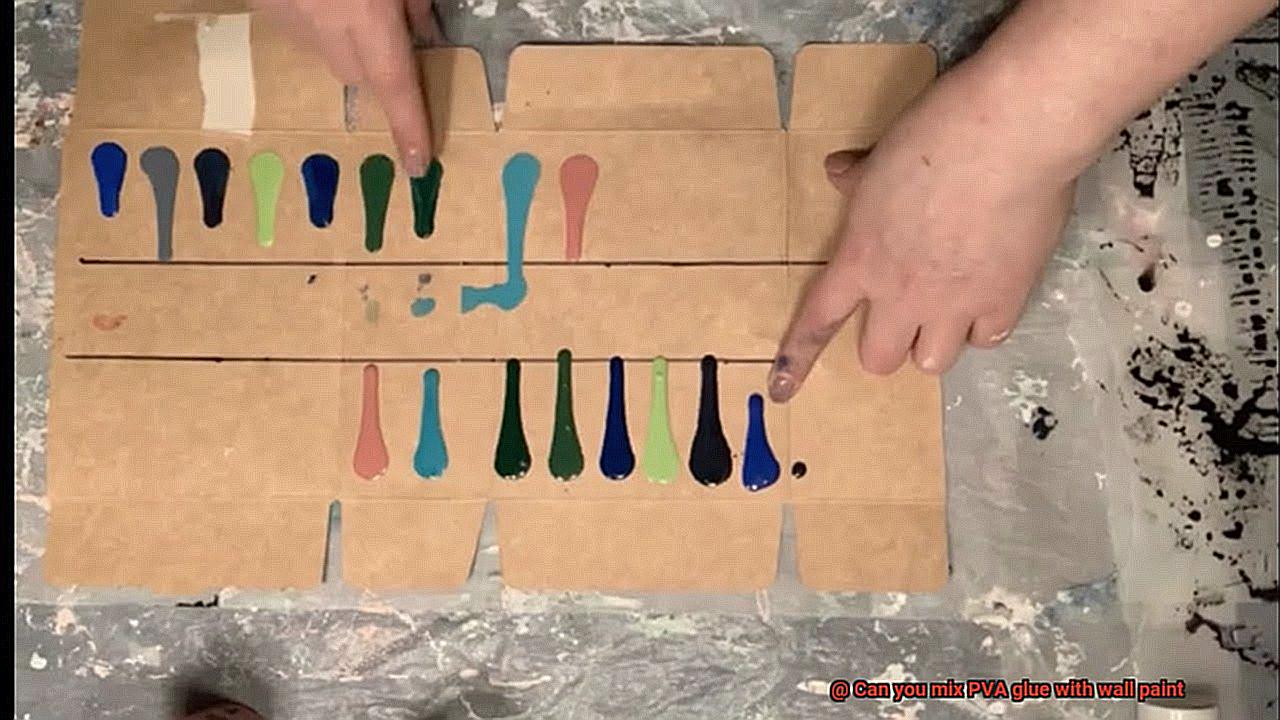
Apply a coat of primer
Applying a coat of primer will improve adhesion and provide a smooth surface for painting. Use a paintbrush or roller to apply an even coat of primer to the surface. Start from one corner and work your way across, ensuring complete coverage. Allow the primer to dry completely before proceeding.
Apply the mixture
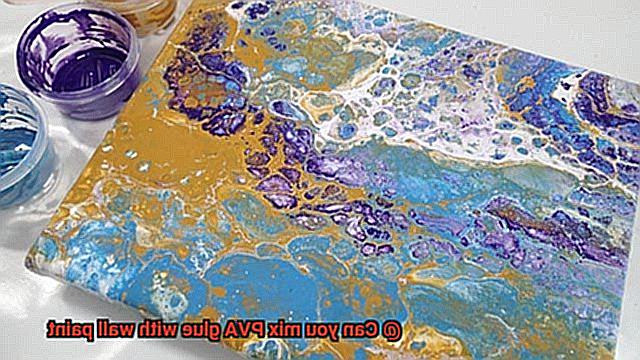
Choose the appropriate application method based on the size and type of surface you are working on. If using a brush, start by “cutting in” the edges and corners of the surface before applying the mixture to larger areas. This technique helps create clean lines and prevents drips or spills.
For larger areas, use a roller or sprayer. If using a roller, start at one corner and work your way in overlapping strokes for an even application. For a sprayer, follow the manufacturer’s instructions and adjust nozzle settings accordingly.
Apply thin, even coats

To achieve the best results, apply the mixture in thin, even coats rather than thick layers. This allows for better drying and minimizes the risk of cracking or peeling. Make sure to cover the entire surface evenly, paying attention to any hard-to-reach areas.
Allow each coat to dry completely before applying additional layers. Refer to the instructions on your specific glue and paint products for guidance on drying times. Applying additional coats too soon can result in a sticky or uneven finish.
Drying Time and Texture Considerations When Mixing PVA Glue and Wall Paint
The drying time and texture considerations when mixing PVA glue and wall paint are crucial factors to keep in mind for a successful application. Let’s dive into an in-depth analysis of these considerations.
Firstly, let’s talk about drying time. PVA glue is known for its quick-drying properties, typically within 15 to 30 minutes, depending on the layer’s thickness. On the other hand, wall paint takes longer to dry, ranging from a few hours to several days, based on factors like humidity, temperature, and paint type. When PVA glue and wall paint are mixed, the presence of PVA glue can accelerate the drying process, potentially causing the mixture to dry faster than using only wall paint. However, it’s important to note that drying time can vary depending on the specific brands and types of PVA glue and wall paint being used. It is advisable to follow the manufacturer’s recommendations and conduct small tests before applying the mixture to larger surfaces.
Now let’s discuss texture. PVA glue has adhesive properties that can affect the texture of the final result when mixed with wall paint. The glue can create a thicker and stickier consistency, altering the texture and viscosity of the paint mixture. The texture may also depend on the ratio of PVA glue to wall paint. A higher amount of PVA glue can make the mixture thicker and more challenging to work with, while a smaller amount may have minimal effects on texture. To achieve a consistent texture throughout the mixture, it is advisable to mix the glue and paint thoroughly in a separate container.
Lastly, let’s consider how the mixture interacts with different surfaces. The texture and adhesion properties of the mixture may affect its interaction with surfaces. The presence of PVA glue can enhance adhesion, making it more suitable for certain surfaces or applications. However, it is crucial to test a small area before applying the mixture to a larger surface to observe any potential differences in texture or adhesion. Properly preparing the surface by cleaning and applying a coat of primer can also improve the mixture’s adhesion and overall results.
Other Important Factors to Consider Before Mixing PVA Glue and Wall Paint
Before embarking on the journey of mixing PVA glue and wall paint, it is crucial to consider several important factors. These considerations will not only ensure a successful outcome but also prevent any unforeseen complications that may arise. Here are some essential points to bear in mind:
- Compatibility: Although both PVA glue and wall paint are water-based, it is imperative to verify their chemical compatibility. Certain glues may not mix well with specific types of paint, resulting in undesirable reactions or compromised paint quality. Always refer to the labels or reach out to manufacturers for guidance on compatibility.
- Intended Use: Contemplate the purpose of mixing PVA glue and wall paint. If your aim is to enhance adhesion or create a textured effect, incorporating small amounts of glue might be appropriate. However, if you intend to dilute the paint for easier application or extend its coverage, using water or a paint thinner may be a more suitable option.
- Longevity and Durability: Assess how the mixture will impact the long-term durability of the painted surface. While PVA glue can improve initial adhesion, it may not provide long-lasting benefits such as preventing chipping, peeling, or cracking. Evaluate the specific conditions and requirements of the surface before deciding whether to mix glue with paint.
- Appearance: Mixing PVA glue with wall paint has the potential to alter the color or sheen of the paint, resulting in an unexpected finish. Conduct a small test patch before applying the mixed solution to a larger area to assess any changes in color or texture. This allows for adjustments if necessary.
- Manufacturer Guidelines: Always adhere to the instructions and recommendations provided by the manufacturer when considering mixing PVA glue with wall paint. Different brands and types of glue and paint may have specific guidelines regarding compatibility and mixing ratios. Consulting product labels or reaching out to manufacturers directly can help ensure optimal results.
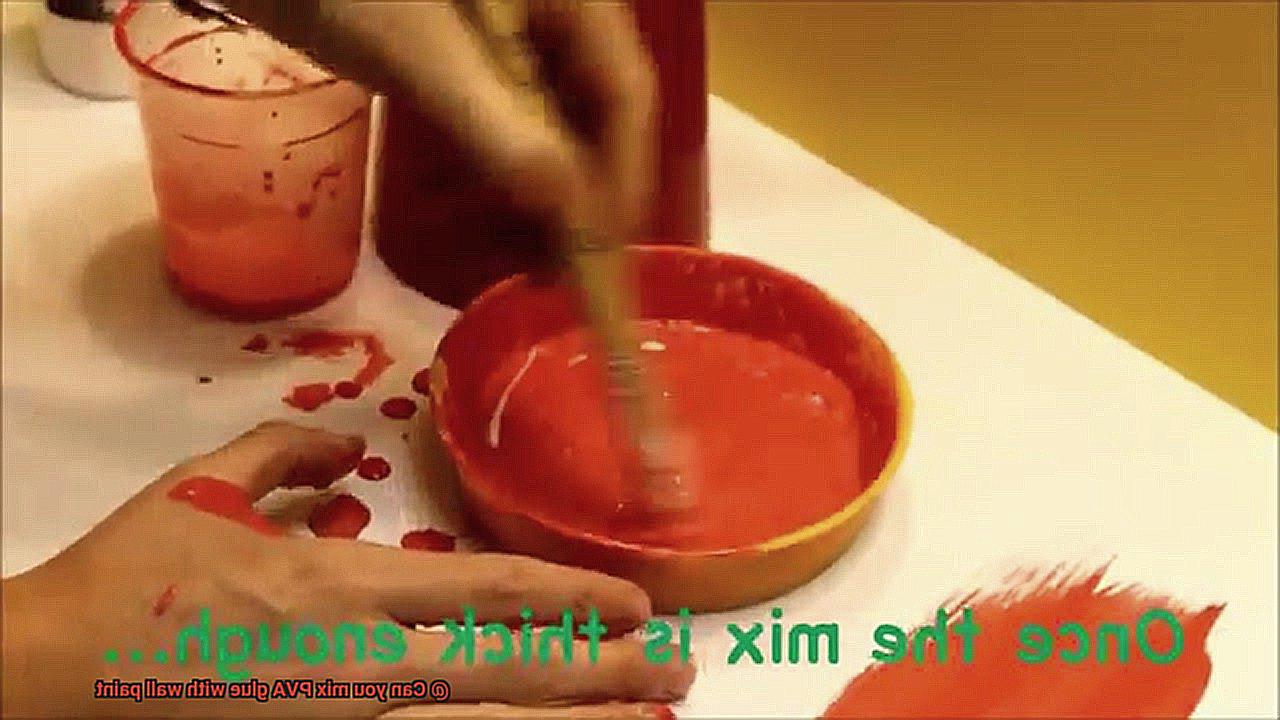
W_b5MnYIZ_k” >
Conclusion
To conclude, the idea of blending PVA glue with wall paint presents a range of pros and cons that warrant thoughtful consideration before diving into your next painting venture.
The benefits of combining PVA glue with wall paint are numerous and enticing. This concoction enhances adhesion, prevents unsightly cracks and peeling, ensures smooth and uniform coverage, bolsters durability, and is budget-friendly. With the help of PVA glue, the paint clings more effectively to surfaces, safeguarding against cracking or peeling while providing a seamless application. It also shields against wear and tear, all without breaking the bank.
However, it’s crucial to be aware of potential drawbacks. Mixing PVA glue with wall paint can compromise the long-term durability of the painted surface. The texture and appearance may suffer as well, leading to streaks or an uneven finish. Moreover, overall coverage and color consistency might be affected. Additionally, using this mixture could void any warranties provided by the manufacturer and make future cleaning or removal more challenging.
To ensure compatibility before applying the blend, conduct a simple test. Gather your materials, mix them in a separate container, apply the mixture to a test surface, allow it to dry completely, and carefully inspect for any negative effects.
When preparing the mixture for application, determine proportions based on personal preference and project requirements. Pour wall paint into a mixing container and gradually add PVA glue while stirring vigorously until thoroughly combined.
Typically, a ratio of one part glue to five parts paint is ideal but adjust accordingly based on factors like surface type and desired adhesion.
To apply the mixture effectively, start by prepping the surface through thorough cleaning and applying a coat of primer. Employ suitable application methods such as brushes or rollers for even coats.
Take note that drying time may vary depending on different brands/types used; it’s wise to test small areas before applying to larger surfaces. Texture considerations come into play due to PVA glue’s adhesive properties, so ensure thorough mixing for consistent texture throughout the mixture. Test compatibility on various surfaces before application to assess adhesion and texture.
Other essential factors to ponder include compatibility, intended use, longevity and durability, appearance, and adherence to manufacturer guidelines.

